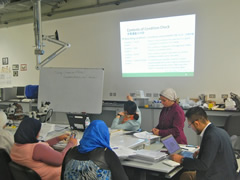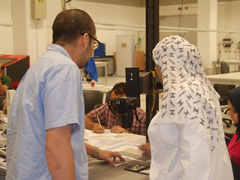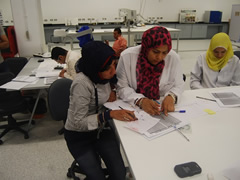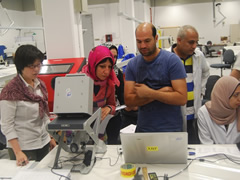- Home
- Technical Cooperation Projects
- Index of Countries
- Middle East
- Egypt
- The Project for the Conservation Center in the Grand Egyptian Museum
- Project News
- Inorganic Objects (Metals) Training course I was held
Project News
2015-08-31
Inorganic Objects (Metals) Training course I was held
At the Grand Egyptian Museum Conservation Center (GEM-CC), Japan International Cooperation Agency (JICA) conducted the training course on Metals (Documentation and analysis) from 25th – 31st August by inviting 2 experts in this field from Japan together with other three instructors who had been in Egypt listed below:
- Dr. Fumiyoshi Kirino: Professor, Conservation Science, Department of Conservation, Graduate school of fine Arts, Tokyo University of the Arts.
- Dr. Akira Fujisawa: Lecturer, Institute of Cultural Properties, Teikyo University.
- Dr. Mariya Masubuchi: Associate fellow, Japan Center for International Cooperation in Conservation, National Research Institute for Cultural Properties, Tokyo.
- Dr. Naomi Hemuki: Conservator
- Mr. Takashi Oikawa: Conservator
10 from the Conservation Center different labs members have participated in the course as main trainees, with an additional 5 members as observers.
The purpose of the conservation program covers not only transfer of conservation techniques, but also build-up of capacities of staffs and organizational systems for overall conservation activities, which include documentation and condition check, decision making of conservation policy, actual conservation work, cooperation with conservation science, and production of survey and conservation report.
This training features the condition survey of metallic artifacts. The degradation including corrosion would rapidly progress once the object is excavated due to the considerable change in surrounding environment. Keeping this in mind, this training enables trainees to evaluate the condition of metallic artifacts by observation and scientific techniques, to collect necessary information for conservation treatment, and also to establish necessary collaborative relationship between conservators and specialists of analytical science.
Metallic artifacts are composed of various metals/alloys, but this training featured the conservation of metallic artifacts made of bronze and copper alloys, and enables trainees to create a conservation plan based on the conservation ethics and scientific results.
In this raining course, Trainees did more practical practice as they were divided into groups and handed a sample and were asked to go through all documentation processes and take turns to analyze it with XRF, XRD and SEM and interpret the analytical data with help from the instructors.
 Ms. Hemuki explaining about documentation.
Ms. Hemuki explaining about documentation.
 A trainee taking a photo for documentation.
A trainee taking a photo for documentation.
 Trainees analyzing analytical data.
Trainees analyzing analytical data.
 Trainees analyzing their samples with XRF.
Trainees analyzing their samples with XRF.
- About JICA
- News & Features
- Countries & Regions
- Our Work
- Thematic Issues
- Types of Assistance
- Partnerships with Other Development Partners
- Climate Change / Environmental and Social Considerations
- Evaluations
- Compliance and Anti-corruption
- Science and Technology Cooperation on Global Issues
- Research
- JICA Development Studies Program / JICA Chair
- Support for the Acceptance of Foreign HRs / Multicultural and Inclusive Community
- Publications
- Investor Relations
